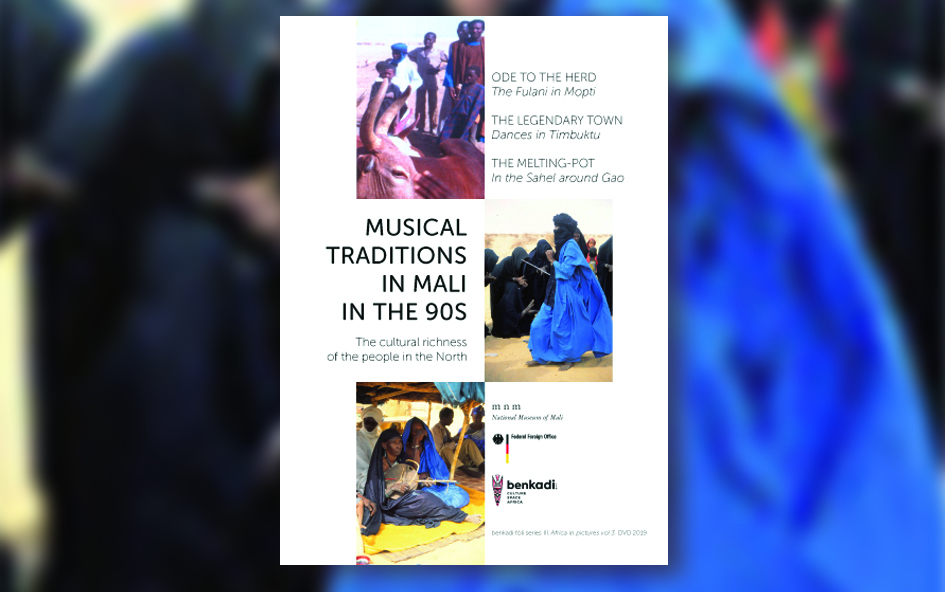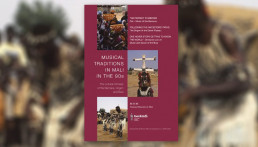This publication is the result of the collection, documentation and safeguarding of the musical heritage in Mali in the 90s, initiated by the National Museum of Mali and executed in collaboration with the International Institute for Traditional Music, Berlin. From a total of 100 hours of video recordings, a selection of 35 minutes for each ethnic group or geographical region has been chosen to present significant parts of their musical identity.The first volume contains three documentaries and starts mainly with the music of the Fulani. Music & dance in the regions of Timbuktu and Gao follow and are dedicated to the musical cultures of the Songhai, the Moors, the Tuareg, and the Daoushaq. Digitized & restored version of the originals from 1993, 1995 and 1996.
MUSICAL TRADITIONS IN MALI IN THE 90s
The cultural richness of the Bamana, Dogon and Bwa
© benkadi fòli series III. Africa in pictures vol. 4. DVD 2021
The second edition of music and dance traditions in Mali begins with the largest ethnic group in terms of numbers, the Bamana in the from Baninko region. At the same time, the first film gives insight into the approach of field research. Two further documentaries introduce the musical heritage of the Dogon of the Stone Plateau and the Bwa in the Tominian region.
THE PERFECT SYMBIOSIS
Fòli – Music of the Bamana (32min)
Only a small part of the rich musical heritage of the Bamana could find its way into this documentation. Nevertheless, the chosen genres testify to the great importance of the interaction of song, instrument and dance at the many different occasions in the life cycle of the Bamana.
FOLLOWING THE ANCESTORS’ PATHS
The Dogon of the Stone Plateau (29min)
The mask dances of the Dogon have established their fame. Furthermore, meaningful funeral songs occupy an important place in their musical repertoire. A wide array of most diverse drum music as well as restrained sounds on flutes and lutes accompany their popular dances at festivities.
ONE NEVER STOPS GETTING TO KNOW THE WORLD
Dimiɲa ɓɛ zun ve
Music and dance of the Bwa (33min)
Buffalo horns, talking drums, xylophones, flutes and harps are played by the Bwa at rituals and public festivities in the savannah of Mali. The fascinating sound of these instruments, the rhythms and the songs offer insight into an ancestral tradition.
 MUSICAL TRADITIONS IN MALI IN THE 90s
MUSICAL TRADITIONS IN MALI IN THE 90s
The cultural richness of the people in the North
© benkadi fòli series III. Afrika in Bildern vol. 4. DVD 2021
The first volume contains three documentaries and starts mainly with the music of the Fulani. Music & dance in the regions of Timbuktu and Gao follow and are dedicated to the musical cultures of the Songhai, the Moors, the Tuareg, and the Daoussahak.
ODE TO THE HERD
The Fulani in Mopti (33min)
Recitations, poems and songs are executed by the Fulani-shepherds in praise of what is most important in their life: the cattle. Besides the expressive vocal music, the one-stringed violin woogéru, the shepherd’s flutes, lutes, and the characteristic calabash drums with their distinctive, brisk rhythms can be heard when the shepherds return home from their long wanderings.
THE LEGENDARY TOWN
Dances in Timbuktu (35min)
From the desert regions of Timbuktu, the takamba-dance has gained great popularity. The delicate sounds of the lamellophone bigini may seem strange alongside modern lute melodies and hard calabash drumbeats. However, the mixture of the cultures of the Moors, the Songhai and the Tuareg in this region brings immense musical surprises.
THE MELTING-POT
In the Sahel around Gao (37min)
The harsh sound of the cylindrical drums hare and the high, elusive tones of the one-stringed lute zarka are characteristic for the desert peoples living in the region of Gao. Their musical richness becomes strikingly evident when the mortar drum tende joins in the sonorous songs or accompanies the famous lute imzad.



